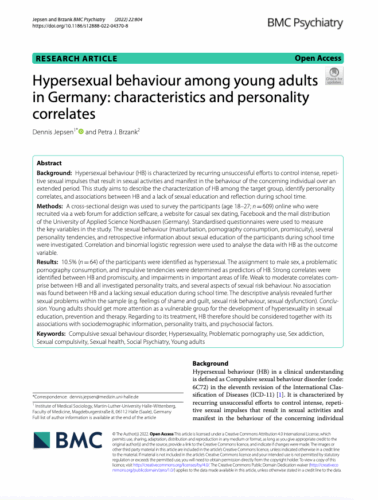Mental Health
Hypersexual behaviour among young adults in Germany: characteristics and personality correlates.
Open Access: No.
Abstract
Background: Hypersexual behaviour (HB) is characterized by recurring unsuccessful efforts to control intense, repetitive sexual impulses that result in sexual activities and manifest in the behaviour of the concerning individual over an extended period. This study aims to describe the characterization of HB among the target group, identify personality correlates, and associations between HB and a lack of sexual education and reflection during school time.
Methods: A cross-sectional design was used to survey the participants (age 18-27; n = 609) online who were recruited via a web forum for addiction selfcare, a website for casual sex dating, Facebook and the mail distribution of the University of Applied Science Nordhausen (Germany). Standardised questionnaires were used to measure the key variables in the study. The sexual behaviour (masturbation, pornography consumption, promiscuity), several personality tendencies, and retrospective information about sexual education of the participants during school time were investigated. Correlation and binomial logistic regression were used to analyse the data with HB as the outcome variable.
Results: 10.5% (n = 64) of the participants were identified as hypersexual. The assignment to male sex, a problematic pornography consumption, and impulsive tendencies were determined as predictors of HB. Strong correlates were identified between HB and promiscuity, and impairments in important areas of life. Weak to moderate correlates comprise between HB and all investigated personality traits, and several aspects of sexual risk behaviour. No association was found between HB and a lacking sexual education during school time. The descriptive analysis revealed further sexual problems within the sample (e.g. feelings of shame and guilt, sexual risk behaviour, sexual dysfunction).
Conclusion: Young adults should get more attention as a vulnerable group for the development of hypersexuality in sexual education, prevention and therapy. Regarding to its treatment, HB therefore should be considered together with its associations with sociodemographic information, personality traits, and psychosocial factors.
Relevance
Hypersexual behaviour (HB), as defined as Compulsive sexual behaviour disorder (code: 6C72 in the 11th revision of the International Classification of Diseases or ICD-11) is defined as as “recurring unsuccessful efforts to control intense, repetitive sexual impulses that result in sexual activities and manifest over an extended period. It is, in short, “excessive masturbation and predominance of autoerotic behaviour, problematic pornography consumption, and promiscuity.”
This study found a relationship between hypersexual behavior and early or adolescent exposure to pornography.
Citation
Jepsen, D., & Brzank, P. J. (2022). Hypersexual behaviour among young adults in Germany: characteristics and personality correlates. BMC psychiatry, 22(1), Article 804. https://doi.org/10.1186/s12888-022-04370-8

